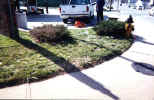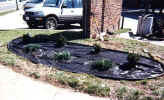Welcome to our
Gardening questions and answers page. If you have any questions about
your garden, or any plants in your garden, please feel free to submit
them at the bottom of this page. We're pretty busy, so give us a day or
two to respond.
Question?
I am constantly having to pull grassy weeds around my Iris. I have
recently decided that hand weeding is against my
religion. Are there any herbicides that will control grassy weeds, but
not harm my Iris's.
Answer:
For this particular problem you will need a herbicide that will kill the
grass, but not the Iris. Trade names for herbicide that will accomplish
this task are:
-
Poast
-
Grass-B-Gon
-
Over-The-Top Weed and Grass
Killer
Be patient, it may take some time for the grass to die. Also, hot and
dry weather may magnify the effectiveness of any chemical you use
in your garden. So be careful not to over do it. Before using any
chemical of any kind in your garden, Please read the label, and
always follow the directions.
Question?
When is the best time of year to seed my lawn? I have heard that you can
seed in the Fall or in the Spring. Is one better than the other? See
also, 7 Steps to
overseeding your lawn
Answer:
The best time of the year to seed your lawn is in the Fall. The second
best time of the year to seed your lawn is in the Spring. Essentially,
Fall is a better time to seed for one big reason. That big reason is
Crabgrass. During the Spring you will want to put a preemergent on your
lawn to prevent the germination of all unwanted annual grasses
(Crabgrass). Seeding your lawn in the Spring gives Crabgrass a window of
opportunity to germinate right along side with the grass that you have
just seeded. If you seed in the Fall, the threat of Crabgrass invading
your lawn does not exist. Generally, any Crabgrass that hasn't
germinated by August probably isn't going to germinate at all (for that
growing season). Therefore, Fall is the best time of the year to seed
your lawn.
Question?
I've heard that Walnut trees will kill some plants when they are planted
too close to Walnut trees. Why is that?
Answer:
The leaves, nuts and roots of Walnut trees produce a toxic chemical
called juglone. Juglone, when taken up by other plants that may be
planted close to Walnut trees, such as, apples, tomatoes, asparagus,
potatoes, lilac and mums, may experience "Walnut Wilt". (not
to be confused with "The Bar Bell Bloat") Plants susceptible
to Walnut wilt will, of course, show signs of wilting and possibly
dying. Another symptom, is that the inner stem tissue of the wilting
plant will turn brown.
It all depends on how close the plants are planted to the walnut tree in
question. Not all Walnuts will kill these plants, the ones that do are:
Persian walnut, pecan, black walnut and butternut. If you want to plant
one of these walnut trees, you will want to plant these well away from
your garden. If you already have a garden close to one of these walnut
trees you may want to remove the walnut tree all together. If you do
remove a walnut tree for this reason, keep in mind that the roots of the
tree will continue to grow for at least one more year, so it is possible
that you will continue to see walnut wilt in your garden, for at least,
two years after the tree has been removed.
Question?
What is a preemergent herbicide? When and how should it be used?
Answer:
First and
foremost: Always read the directions and any warning labels that are on
any herbicides that you might be applying to your lawn. Always.
Herbicides can be
put into two categories. Preemergent and postemergent.
A preemergent herbicide is applied to a lawn or flower bed before the
target weed (the weed you are trying to kill) has germinated. It is
usually applied in granular form.
A postemergent herbicide is applied to a lawn or flower bed after the
target weed has germinated. It is usually applied in a liquid form (but
not always).
In the Kansas City area, preemergent herbicides are predominantly used
to control crabgrass (annual seed grasses) in lawns. A preemergent would
be applied to a lawn in the Spring, before the crabgrass germinates
(early March to April). Preemergents are not meant to kill crabgrass
after it has germinated. I have been told that Dimension, a popular
preemergent can kill crabgrass if it has recently germinated, however,
this is not something that should be counted on. This means, that for
best results, you should time your application prior to the germination
of the crabgrass in your area. Crabgrass germinates when the soil
temperature reaches approximately 60 degrees. The timing of your
application should be before this. A good indicator is to watch for when
the Forsythia blooms. When you see this, go ahead and put your
preemergent on your lawn. It may not sound all that scientific, but it
does work.
After you apply a preemergent
to your lawn be sure to water it in. Most preemergents do not become
effective (chemically activated) unless they are watered in after they
have been applied to a lawn.
Also, do not disturb the soil
surface in any way unless you have to. Disturbing the area of
application will probably nullify the effectiveness of the chemical.
Question?
....Really like the "Flower of the Month",
especially the list of companion plantings. I used your feature
to e-mail the site to my friend Cindy in Bashor.
Got a newsletter from
Savvy.. and they reprinted the article you sent me from KS (wherever)
about ambient temperature and plants and drying conditions -
even the part about the mice eating your trees!!! What a
scam. Do they have original thoughts??? I can relate with
them in that their seed starters didn't work last year - mine
didn't either.
Keep up the good work.
-CS (Also like GW's jet)
GW's
jet 
Answer:
You know I signed up
for Savvy's ( www.savvygardener.com/
) newsletter but I guess I need to do it again because I
didn't receive a newsletter from them. I am finding out (especially
during the winter mos.) that content for a site is hard to come by I
guess. (Or probably the time to write original content is hard to come
by.) You wouldn't believe the amount of time I've got into my site and
it's just 5 pages. Savvy(and correct me if I'm wrong) probably has 20
to 30 pages. Let me put it this way, the internet is like
Rock n Roll in that everybody is stealing from everybody else. (and of
course, you can quote me on that, mate)
It's basically
the nature of the medium and information is the commodity. As far as
I'm concerned, if it gets knowledge to the person surfing your site,
and it answers their question(s), then great, who cares where the
info. came from.
Question?
I
have weeds growing around a Dutchman's Pipe. Do you have any ideas on
what I could do? Please, I need help!
Mathew
Answer:
Mathew,
not having grown Dutchman's Pipe or Aristolochia, I can't recommend any
weed preventing chemical solutions for this problem (however,
preemergents will probably work, but definitely not any broadleaf weed
killers), however, I will tell you what I do for my Morning Glories or
any other plants I have this same problem with (ornamental grasses).
Remove all of the unwanted weeds from around the base of the plant, then
put weed mat down around the plant(s) that you are trying to keep
the weeds away from. If you do this, buy a good quality weed mat so that
it will last several years. Also, be aware, that if you put a weed
mat down, it could hinder the spreading of any perennials in the same
proximity of your flower bed. Weed mat is a great way to keep the weeds
out of your flower beds. It is a physical barrier that lets the water
get to your plants, while not letting the weeds grow in your bed, and,
best of all, it does this without the use of chemicals. After installing
the weed mat then place a mulch (wood, rock, whatever you prefer (I
always prefer wood mulch because my lawn mower has a tendency to throw
the rock through windows)) on top of the mat. Here's a picture to give
you some idea of how to install your weed mat. One last note, make sure
that you secure the weed mat down with garden staples, and don't be
stingy with the staples. Use a staple at least one every two feet or
so(especially along seams in the middle of the bed), this should keep
the mulched flower bed looking good for a long time.


Question?
Before
the snow and frigid cold this year, I mulched my perennial bed.
Now that the snow is gone, the mulch looks much thinner. Should I
mulch again, or is it too late to do any good?
Carol
Answer:
Carol,
I highly recommend that you remulch your bed. One of the mistakes that
homeowners make, that I have noticed over the years, is that they don't
mulch their beds with the proper amount of mulch. (I'm talking about
wood mulch here) When you mulch a bed, you should spread the mulch so
that it is at least 2 inches deep. I would recommend
that if you are mulching a bed for the first time you need to put at
least 3 to 4 inches of mulch on a new bed. After that, top dress
(another 1 to2 inches) the bed as needed. "As needed", is up
to the homeowner, however, to keep the bed looking in top form, I would
suggest that "as needed" is twice a year. Using enough mulch
is the best thing you can do to protect your perennials from the cold
weather and desiccation during the winter months. The
combination of cold weather and desiccation will probably terminate a
lot of plants in our gardens this year. The cold weather we can't do
anything about, however, proper mulching (and watering during the winter
months) will minimize the negative effects of desiccation.
Do not over mulch your
beds. I've only seen this twice in 15 years so it isn't a very
common problem. If you get to the point where your layer of mulch is 5
inches thick you may create an environment where there is no oxygen
underneath the layer of mulch. Over time, due to compaction and rot, the
wood chips create oxygen poor zone underneath the mulch. This means that
the roots of your plants aren't getting any oxygen, and therefore, will
either die or do very poorly (depending on the plants and the amount of
oxygen available). It takes a long time and a lot of mulching to produce
this condition (also a lot of neglect). At this point, you need to
remove the old mulch, find a way to aerate the soil without disturbing
your plants or just redo the bed entirely.
Other suggestions when mulching flower beds:
Find a way to contain the
mulch in your bed. Use either black plastic landscape edging
(be careful when your mowing), metal edging (be very careful when your
mowing) or just do what I do and edge by digging a small trench. This
will delineate your bed from your lawn area and improve the look of your
bed considerably. This will also minimize the amount of mulch that
spills out onto your sidewalk or lawn area during a hard rain.
If you use a dyed mulch
your bed will look in top form for a much longer period of time.
This will reduce the number of times a year that you have to top dress a
bed. When using the usual wood chips (hardwood or whatever) you will
notice that after about 3 months the sun washes the color out of the
mulch, and the bed doesn't look nearly as good as when it was freshly
installed. Dyed mulches are more expensive, but if you only have to top
dress them once a year, as opposed to twice a year as with regular
hardwood mulches, then they are cheaper and keep your bed looking good
throughout the growing season.
Please
submit any gardening questions you might have in the form below. We
will do our best to answer all questions as soon as possible, thank
you.
|

